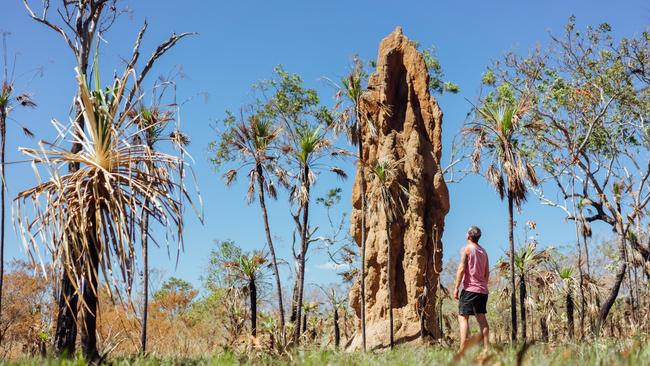Stop for startling finds on the road to Litchfield National Park
The road from Litchfield to Darwin yields some quirky discoveries.

Australia is famous for “big things” but in Batchelor, gateway to the Northern Territory’s Litchfield National Park, a quirky “little thing” catches my eye. Perched on a rocky outcrop on an otherwise unremarkable suburban street is a miniature eastern European gothic castle, complete with snaggle-toothed walls and cone-shaped turrets painted the same vivid shade as northern Australia’s cloudless sky.
I’m fresh from swimming in Litchfield’s inviting waterholes — Florence Falls and Buley Rockhole — and trying to return to Darwin, except there are many roadside distractions along the way. Within the national park, I’ve been pulling over regularly to gawk at termite mounds, soaring more than 5m into the tropical air. They’re fantastical, a rival to anything dreamed up by Gaudi in faraway Spain. The mounds are mega-mansions, castles in the sky, for cathedral termites, measuring just 5mm long.
Top End architecture takes many forms, and Batchelor’s regal monument is so unlikely that I simply must know more. Plaques reveal the story of how Bernie Havlik took it upon himself to fashion a replica of 14th-century Karlstejn Castle, a World Heritage-listed drawcard southwest of Prague in the Czech Republic. Havlik spent his formative years in what was then Czechoslovakia before moving to Yugoslavia, then Australia.
After jobbing around three states, he landed in the Northern Territory and worked for the Rum Jungle uranium mine near Batchelor. When operations closed in 1971, Havlik joined the town’s gardening crew. By all accounts, the unwieldy patch was a constant frustration. After retiring in 1977 he decided to do something about it. The following year, he started transforming the pimple of rock into his version of a beauty spot. Construction officially concluded in 1983 but he continued to maintain his pride and joy until his death in 1990. Today, the area surrounding the castle is known as Havlik Park.
What Batchelor (population 500) lacks in size it makes up for in unusual sights. I stop again to inspect St Barbara’s Catholic Church, a prefabricated 1954 structure. Barbara is patron saint of artillerymen and miners, and the church was well patronised by Irish miners who flocked to Batchelor. Handmade metal lettering spells out the church’s name above the entrance. A peek inside the open louvre windows that allow for cross-ventilation reveals cypress-pine pews made on Melville Island and a cool coloured-concrete floor.
Before uranium was discovered at Rum Jungle in 1949, Batchelor and other parts of the Top End had been reshaped by World War II. Following Japanese attacks on Darwin in 1942, dozens of airstrips were carved into roadside verges to help fight the air war in Australia’s north. They’re still there, bordering the Stuart Highway heading into Darwin. As I ease back into the city along Tiger Brennan Drive, named in honour of the late, colourful mayor, I make one last stop.
Charles Darwin National Park is home to a network of challenging mountain-bike tracks, pretty birds such as the double-barred finch, countless midges, and explosives storage bunkers that were part of a web of military sites supporting Darwin’s role in our northern defence line. The city, not much more than a shanty town during World War II, was bombed 64 times over nearly two years. Although the site once seemed far removed from Darwin, these days you can admire the city’s low-key skyline from a viewpoint above the Port Darwin wetlands. Nearby is a series of gunmetal-grey doors that seem to lead directly into scrubby hillocks. This bumpy country helped to disguise the structures from the enemy.
Flung-open doors on one bunker invite you inside to learn more. Here, you can read about the Allied war effort and see memorabilia such as bomb trolleys, typewriters and storage chests. An open box contains rosemary, a memory-enhancer since ancient times and a popular accessory on Anzac and Remembrance days. Lest we forget.
Katrina Lobley was a guest of Tourism NT.
■ northernterritory.com

To join the conversation, please log in. Don't have an account? Register
Join the conversation, you are commenting as Logout